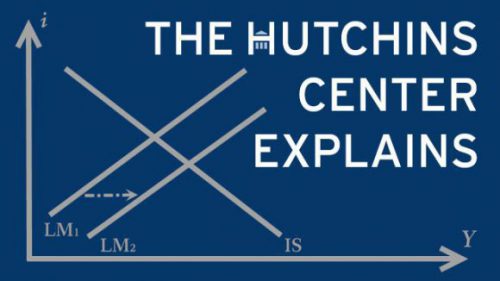After years of keeping its key short-term interest rates near zero, the Federal Reserve has begun raising them. But it is not raising rates in exactly the same way that it used to. Here’s a primer.
What is the Fed’s key short-term interest rate?
The Fed’s most important interest rate is the federal funds rate, the rate that banks charge when they lend to each other overnight. By law, banks are required to keep a certain amount of reserves at the Fed. Think about bank reserves as a checking account for banks; all banks have to maintain a minimum balance (reserve requirements). If banks are running low on required reserves, they borrow from other banks at the federal funds rate; if they have extra reserves, they can lend to another bank at that rate.
Before the global financial crisis, the Fed would raise the federal funds rate by selling U.S. Treasury securities in open market operations. Banks would pay for these securities by reducing their reserves, and reducing the supply of reserves would push up the price – the federal funds rate — that banks had to pay to borrow reserves. When the Fed wanted to lower rates, it would buy U.S. Treasury securities.
The federal funds rate matters not only to banks. It’s an important benchmark for other interest rates in the economy. When the federal funds rate goes up, so does the rate that borrowers pay on car loans or adjustable rate mortgages and the rates savers get on certificates of deposit and money market funds. Here’s how the federal funds rate has behaved over time. Notice how other interest rates move with it, albeit with a lag.

Why can’t the Fed use the same open market operations to raise rates today?
When the federal funds rate hit zero in 2008 and the economy still needed more monetary stimulus, the Fed moved beyond influencing short-term interest rates to try to influence longer-term interest rates, buying more than $3 trillion in U.S. Treasury and mortgage-backed securities in what it calls Large Scale Asset Purchases (or LSAPs) and what everyone else calls Quantitative Easing (or QE). By increasing the size of its balance sheet with these purchases, the Fed created a lot of excess reserves in the banking system. With so many reserves, the Fed could no longer move the federal funds rate by buying and selling relatively small amounts of securities from its portfolio as it did in the past. So it had to find a different approach to influence short-term interest rates.
What is the Interest on Excess Reserves (IOER)?
In the past, the Fed did not pay banks any interest on the extra reserves they kept in their accounts at the Fed. Beginning in 2008, the Fed started paying interest – the Interest Rate on Excess Reserves (IOER). The IOER effectively put a floor under the short-term interest rate that banks charge each other to borrow reserves. No bank would lend money to another bank at a rate lower than the one it could get simply by leaving its excess reserves on deposit at the Fed. The New York Fed provides information on how this works, and some Fed economists argue that it improves the efficiency of the payments system overall in addition to giving the Fed control of rates.
And what is the Overnight Reverse Repurchase rate (ONRRP)?
By law, only banks can earn the IOER on deposits at the Fed. But other financial institutions – Fannie Mae, Freddie Mac, hedge funds, money market funds – can and do make short-term loans to domestic banks and U.S. branches of foreign banks, and they’re often willing to lend at an interest rate below the IOER. Without some additional steps by the Fed, this would make it hard for the Fed to control the federal funds rate and thus, influence, short-term rates throughout the economy.
In response, the Fed launched the Overnight Reverse Repurchase Agreement Facility (also known as ONRRP) through which it borrows money from non-bank entities at an interest rate it sets. Non-banks with money to lend have no incentive to lend money to a bank at a rate lower than the ONRRP rate, effectively setting a floor under short-term rates for the whole market. A primer from the New York Fed provides details. Research from economists at Stanford suggests that ONRRP strengthens the effective transmission of monetary policy through the economy.
So how does the Fed use these new tools to influence the federal funds rate?
Even after implementing IOER and the ONRRP, the Fed still decided to focus on the federal funds rates as its key benchmark interest rate. In practice, the federal funds rate is somewhere between the IOER and the ONRRP rates. So when the Fed began raising short-term interest rates in 2015, it did so by setting a higher level for the IOER and the ONRRP rate. More recently, when the Fed raised interest rates in December 2017 for example, it set the ONRRP rate at 1.25% and IOER at 1.5% and set its target for the federal funds rate between 1.25% and 1.5%. Since then, the federal funds rate has been around 1.4%, the middle of the range. The chart below shows how the ONRRP rate, the IOER, and the federal funds rate have moved since the Fed started using the ONRRP facility in September of 2013.

This shift in the Fed’s strategy to use IOER and ONRRP rates with the federal funds rate, has been outlined in detail by Fed economists. In a review of the new procedure, Stephen Cecchetti of Brandeis and Kermit Schoenholtz of NYU concluded in March 2017 that it was “working as well as anyone could have hoped,” but cautioned that it hadn’t been tested in a period of financial distress.
This new approach has stirred some controversy on Capitol Hill. What’s that all about?
There has been some criticism of the Fed over its payment of IOER to banks holding reserves at the Fed. Critics suggest that IOER amounts to a subsidy to the banks, one that discourages them from lending. These critics observe that the IOER is set above the interest rate that ordinary retail depositors and other market participants get on their money. So banks could, for instance, borrow at the federal funds rate and then deposit the money at the Fed at a higher rate.
George Selgin, a Cato Institute economist, is among the most vocal critics of the way the Fed uses IOER. In addition to endorsing the notion that it subsidizes banks, Selgin argues that paying interest on reserves gives the Fed too much power, enables the Fed to maintain a larger portfolio than it did before the crisis, and leads to a misallocation of credit in the economy.
“[The Fed’s current operating framework] places the Fed in command of an excessively large share of the public’s savings, which it steers towards the government and housing market and whatever other markets its administrators choose to favor, depriving other borrowers of that much potentially productive credit.”
The chairman of the House Financial Services Committee, Jeb Hensarling (R, Texas), echoed this sentiment at a July 2017 congressional hearing.
“What has allowed the Fed’s foray into credit allocation is the policy of paying interest on excess reserves, and today, paying a premium over market. Interest on ‘required’ reserves was meant to counteract an implicit tax. Interest on ‘excess’ reserves should not become a permanent tool of monetary policy. Normalization would suggest, after setting the level of reserves, short-term interest rates be set by market forces. But today they are set from the top down by an administered rate paid on excess reserves, which again, is a premium rate resting on uncertain legal authority.”
What’s the Fed’s response?
Fed officials defend IOER as a legitimate policy tool, one that is employed by the Bank of England, the European Central Bank and the Bank of Japan and one that is essential for making monetary policy at times when the federal funds rate falls to zero. (Without the IOER, it would be impossible for the Fed to engage in quantitative easing without losing control of interest rates altogether.)
The Fed challenges the idea that it is a subsidy to banks. They observe that banks can’t profit as easily as the critics assert by borrowing reserves at the federal funds rate and depositing them at the Fed to earn IOER. To do so, a bank would have to increases its reserves, but that carries a cost: the insurance premiums they have to pay to the Federal Deposit Insurance Corp. Non-banks don’t bear this cost. In addition, a provision of the Dodd-Frank law passed after the financial crisis requires banks to maintain cash buffers that they could otherwise use to lend to consumers and businesses. This also comes at an additional cost. The Fed claims that collectively, these costs largely cancel out the average 0.13 percentage point profit that banks might make by borrowing at the fed funds rate and depositing the money at the Fed to earn the IOER. One important exception is that foreign banks don’t pay FDIC premiums, so they may be able to take advantage of borrowing in the market and depositing that money at the Fed to earn IOER, as some Fed economists have documented.
For these reasons, and as former Fed Chair Ben Bernanke and Vice Chair Don Kohn have outlined, the Fed’s use of IOER presents more of a political or perception problem than a policy one:
“Although the payment of interest on reserves provides no meaningful subsidy, the Fed does face an appearance problem from the fact that it is writing checks to banks.…Of course, misplaced criticism is no reason not to do the right thing with monetary policy. But the Fed will need to make good economic arguments to explain why paying interest to banks is necessary.”
Asked at his March 2018 press conference about the argument that IOER is a subsidy to banks, Fed Chair Jay Powell responded:
“You mentioned the question of interest on excess reserves. And I think it is a little bit of a misnomer to think that there’s a subsidy [to banks] there. We pay interest on excess reserves. We can’t pay interest on excess reserves that are above the general level of short-term interest rates. So we’re paying rates that banks can get from other interest rates from any other investment in the short-term money markets. In addition, remember that those are our liabilities. The assets that we have on the other side [of the balance sheet] are Treasury securities and mortgage-backed securities, which yield much higher than interest on reserves. So in fact, it is not a subsidy, and it is not a cost to the taxpayer.”
Why is the IOER so much higher than the interest rates that banks pay consumers on their savings?
Despite the Fed raising interest rates, IOER has still been quite a bit higher than basic retail deposit rates that consumers get on their savings, CD and money market accounts. Fed economists argue that the reason for this is that retail deposit accounts tend to be ‘sticky’, that is, they react less quickly to the Fed’s interest-rate moves than other market rates. Particularly, with the level of rates so low, banks have not yet increased the rates they pay depositors, preferring to retain the profits instead. As rates continue to rise, these deposit rates are likely to rise as well.
The Brookings Institution is committed to quality, independence, and impact.
We are supported by a diverse array of funders. In line with our values and policies, each Brookings publication represents the sole views of its author(s).







Commentary
The Hutchins Center Explains: How the Powell Fed will raise interest rates
March 15, 2018